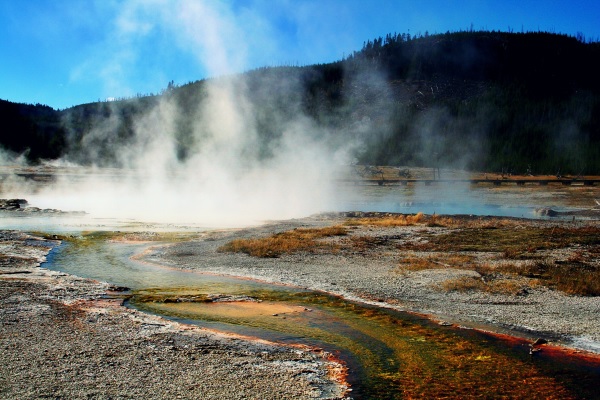Geothermal Installation – In the realm of modern development and technological progress, energy stands as the linchpin. As the world’s population burgeons and the appetite for energy escalates, the quest for eco-friendly and sustainable energy solutions has become increasingly urgent. Emerging as a notable alternative is geothermal energy. In this discourse, we delve into the fundamental principles of geothermal energy, its generation, merits, impediments, applications, and future prospects.
What Is Geothermal Energy
Geothermal energy is a renewable energy variant harnessed from the Earth’s internal heat reservoirs. This thermal energy originates from the radioactive decay of elements within the Earth’s core and residual heat from the planet’s formation. Geothermal energy finds application in electricity generation and serves as a heat source for heating and cooling systems. Its remarkable sustainability stems from its minimal production of greenhouse gas emissions.
Geothermal Installation and Production
The journey of producing geothermal energy commences with rigorous exploration and drilling endeavors. The selection of potential geothermal sites demands precision, for not all regions possess adequate geothermal resources. Once a suitable location is identified, a geothermal borehole is meticulously drilled into the Earth.
Upon reaching a geothermal reservoir, a fluid, typically water or a specialized liquid, is introduced into the well. As this fluid traverses the reservoir, geothermal heat imparts thermal energy to it, converting it into scalding steam or gas. This high-temperature steam or gas is subsequently channeled to a turbine, where it propels a generator, yielding electricity.
Beyond electricity generation, geothermal energy can be directly employed for heating residential and commercial spaces. In this system, subterranean hot water is routed into structures, serving to warm rooms and provide hot water.
Advantages of Geothermal Energy
Geothermal energy boasts several advantageous attributes that render it an increasingly alluring alternative energy source:
- Sustainability and Environmental Friendliness: Geothermal energy stands as an inexhaustible renewable source, guaranteed to persist as long as the Earth endures. Additionally, its utilization refrains from the emission of greenhouse gases, thus contributing to the mitigation of climate change.
- Uninterrupted Availability: Differing from solar and wind energy, geothermal power generation remains impervious to weather conditions or seasonal fluctuations. It functions around the clock, offering a dependable primary energy source.
- Positive Economic Impact: The geothermal energy sector bolsters local economies by generating jobs and fostering investment opportunities. Furthermore, reliance on imported fossil fuels can be curtailed, thereby bolstering national economies.
Challenges and Hurdles of Geothermal Energy
Despite its merits, geothermal energy confronts various challenges:
- Limited Geographic Reach: Suitable geothermal reservoirs are confined to specific regions, such as those along the Pacific Ring of Fire. Consequently, access to geothermal energy is geographically constrained.
- Substantial Initial Investments: Launching a geothermal energy project demands substantial upfront investments for exploration and infrastructure development, potentially deterring countries with limited resources.
- Environmental Management: While geothermal energy is deemed environmentally benign, the operation of geothermal power plants can still inflict ecological impacts, including soil erosion and water consumption. Effective management is requisite to minimize these effects.
Applications of Geothermal Energy
Geothermal energy finds diverse practical applications in daily life, including:
- Electricity Generation: A primary application of geothermal energy involves electricity production, catering to the energy needs of households and industries.
- Space Heating: Geothermal energy is harnessed to provide heating for residential and commercial structures, diminishing reliance on fossil fuels.
- Industrial Use: Certain industries incorporate geothermal energy into their manufacturing processes, such as agricultural product drying or food production.
Geothermal Installer in Some Country
Several countries have successfully harnessed their geothermal energy potential, with notable examples including:
- Iceland: Iceland emerges as a global leader in geothermal energy adoption, with approximately 90% of its households relying on this resource.
- United States: The United States boasts some of the world’s largest geothermal power plants, situated in states like California and Nevada.
The Promising Future of Geothermal Energy
The horizon for geothermal energy appears promising, thanks to ongoing research and innovation in geothermal technology. As awareness of climate change heightens and the quest for renewable energy intensifies, geothermal energy assumes an ever-more pivotal role in global endeavors to attain clean energy objectives.
Conclusion
Geothermal energy, derived from the Earth’s internal heat, represents a renewable energy source with immense potential. It is poised to play a significant role in global efforts to curtail greenhouse gas emissions and supplant fossil fuels. Notwithstanding the challenges, its myriad advantages and diverse applications render it a compelling alternative for building a more sustainable energy ecosystem. With continued investments in research and development, the future of geothermal energy shines even brighter.
FIND IT HERE
